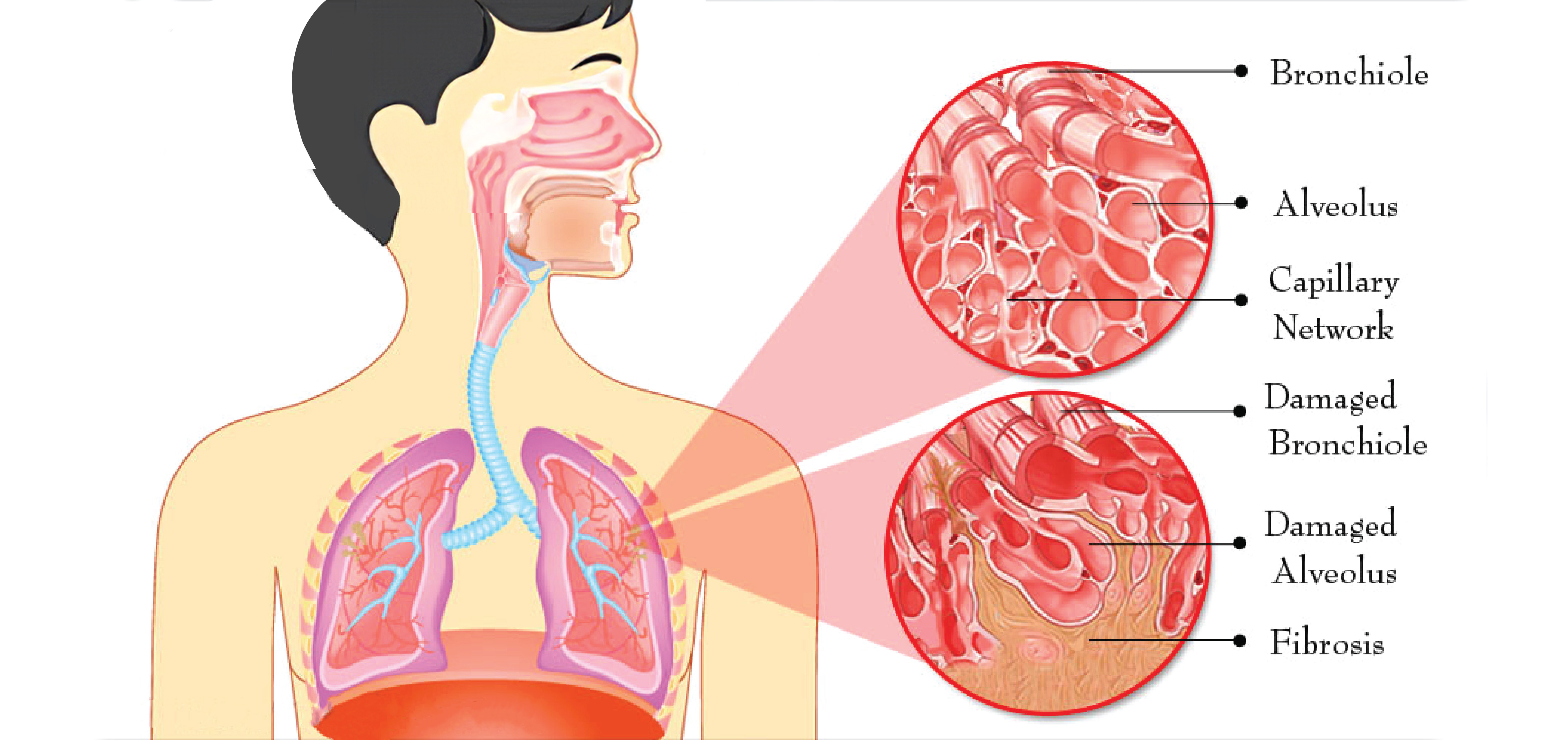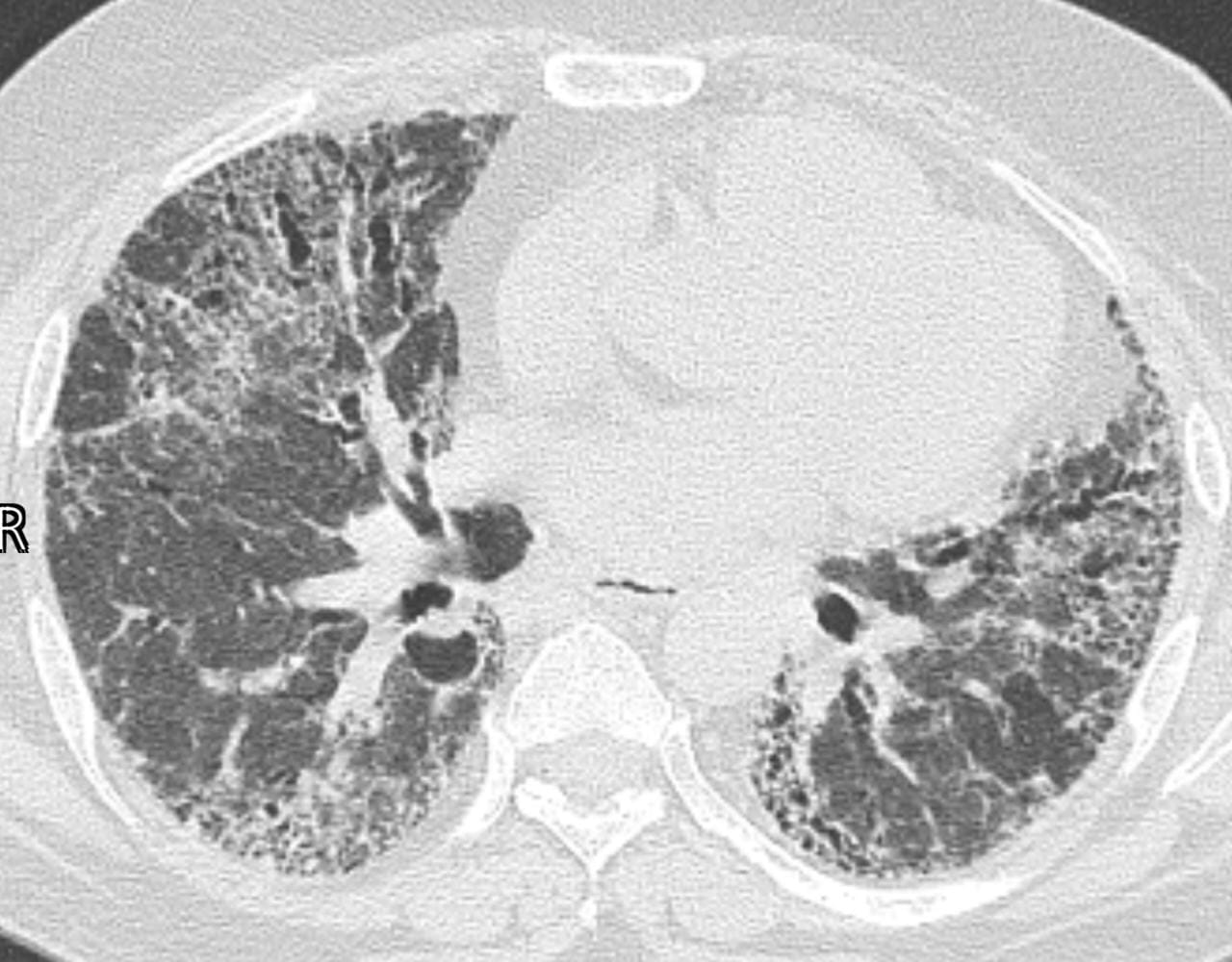Pulmonary Fibrosis

Pulmonary Fibrosis, a condition which results in scarring and stiffness of the lung tissues. It makes breathing a challenging task for patients as the body is unable to get enough oxygen, which may lead to respiratory failure, heart failure or other problems.
Researchers believe that Pulmonary Fibrosis is mostly caused by variety of factors such as genetics, immune system activity, smoking, exposure to certain lung irritants like chemicals and infections.
At first it was thought that the inflammation is the main cause of this condition but it is now believed that scarring of the lungs is caused by a peculiar healing process. Pulmonary Fibrosis is the result of significant lung scarring, over time.
What are the symptoms of pulmonary fibrosis?
Pulmonary Fibrosis may be asymptomatic for some time. The first symptom that usually develops is shortness of breath.
Other symptoms may include:






Early symptoms are often misattributed because of age or lack of exercise and it is found to generally affect older adults.
You may experience minor symptoms at first which can progress over time. The symptoms usually vary from person to person. People with Pulmonary Fibrosis get sick very quickly.
What causes Pulmonary Fibrosis?
There are several categories that cause Pulmonary Fibrosis:
Autoimmune diseases
When your body’s immune system destroys its own cells causing various conditions like Pulmonary Fibrosis, it is termed as autoimmune diseases. Pulmonary fibrosis can be caused by various autoimmune conditions such as:
- Rheumatoid Arthritis
- Lupus erythematosus, which is commonly known as lupus
- Scleroderma
- Polymyositis
- Dermatomyositis
- Vasculitis
Environmental exposure
Getting exposed to certain things in the environment or workplace can also lead to Pulmonary Fibrosis. Cigarette smoke consists of many chemicals that can potentially damage the lungs and may lead to this condition.
In India, exposure to pigeon and other birds material like feathers, droppings etc is a very common cause leading to Pulmonary Fibrosis. Other contributing factors are:
Medications
The chances of developing pulmonary fibrosis increases with certain medications. Taking any of the medications listed below on a regular basis requires close monitoring by your doctor:
- Chemotherapeutic drugs such as cyclophosphamide
- Antibiotics, for eg. nitrofurantoin and sulfasalazine
- Cardiac drugs, for eg. amiodarone
- Biological medications such as adalimumab or etanercept
Idiopathic
There may be cases when the exact cause of the pulmonary fibrosis is not known. When the cause is unknown, the condition is termed as Idiopathic Pulmonary Fibrosis.
As stated by American Lung Association, IPF is the most common type of pulmonary fibrosis.
Genetics
The Pulmonary Fibrosis Foundation states that about 3-20 percent of patients with IPF have a family relative with Pulmonary Fibrosis and it is called as Familial Pulmonary Fibrosis or Familial Interstitial Pneumonia.
Scientists are investigating the role of genetics in pulmonary fibrosis.
Who is at risk of Pulmonary Fibrosis?
Your odds of getting diagnosed with pulmonary fibrosis are higher if you:
- are male
- smoke
- have a family history of the condition
- have an autoimmune disorder
- take certain medication for the disease
- have received cancer treatments, especially chest radiation

How is pulmonary fibrosis diagnosed?
There are over 200 types of lung diseases amongst which pulmonary fibrosis is the most common type. Identifying the cause of your symptoms can be a challenging task, since there exist different types of lung diseases.
Your Pulmonologist will accurately be able to diagnose your disease with the help of type of your CT scan and the clinical information provided.
A biopsy may be necessary in certain cases where the diagnosis is opaque. Your physician will then suggest the suitable procedure for you.
Other diagnostic tools can also be used to rule out the possibilities of other conditions like,
- Pulse oximetry, uses electronically generated signals for your blood oxygen levels
- Blood tests to check for autoimmune diseases, infections and anemia
- An arterial blood gas test to precisely analyze the blood oxygen levels.
- Assessing sputum sample for any signs of infections
- Pulmonary function test to check lung capacity
- Six minute walk test to check your exercise tolerance.
- An echocardiogram or cardiac stress test can be done to assess for symptoms caused by heart problems.
How is Pulmonary Fibrosis treated?
The scarring of the lungs cannot be reversed even by doctors, so they recommend treatment options which help to improve your breathing and to decrease the growth of the disease.
The current treatment options available for the management of the disease are:
- Supplemental Oxygen
- Prednisone to suppress your immune system and minimize the inflammation
- Azathioprine or mycophenolate to suppress your immune system
- Pirfenidone or Nintedanib, antifibrotic drugs that block the scarring process in the lungs.
Your physician may advice you to alter your lifestyle such as:




In case of severe disease, lung transplant may be considered for patients under the age of 65.
What is the outlook for people with Pulmonary Fibrosis?
There is variation in the rate at which the scarring occurs in people’s lung in Pulmonary Fibrosis. The scarring is irreversible but the treatments prescribed by your doctor will help reduce the progression rate of the disease.
Number of complications are observed including respiratory failure when the functioning of lungs is hampered and they are unable to supply enough oxygen to your blood.
Chances of lung cancer are increased in Pulmonary Fibrosis.
Tips for prevention
Not all cases of Pulmonary Fibrosis are preventable. There are other cases also where environmental and behavioural risk factors can be controlled. Following these tips can help reduce the risk of getting the disease:
- stop Smoking
- avoid passive smoking
- use a face mask or other breathing devices, if you work in a place with hazardous substances
Schedule an appointment with your Pulmonologist if you face difficulty in breathing. Most of the lung diseases including Pulmonary Fibrosis can be treated and an early diagnosis helps to improve long-term prognosis of the patient.
 Call For Appointment
Call For Appointment